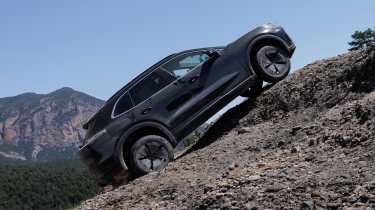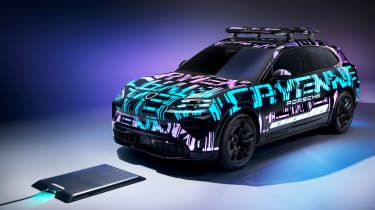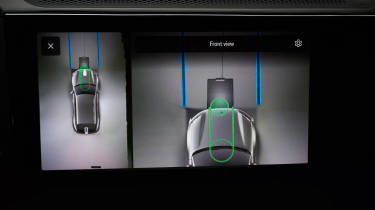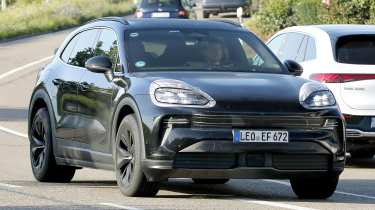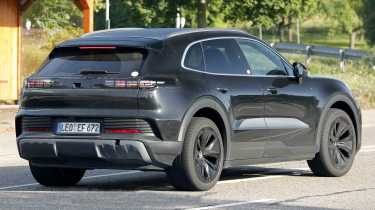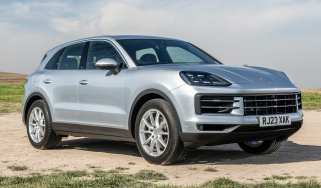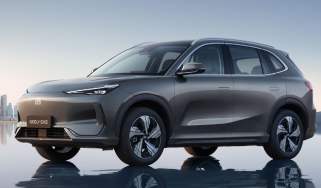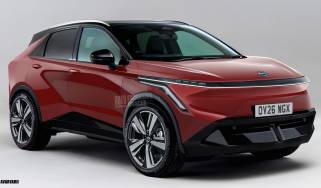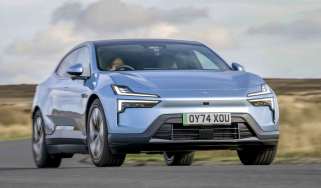New Porsche Cayenne Electric testing ramps up as reveal edges ever closer
While real-world testing remains vital for a fully developed car, Porsche is discovering the benefits of virtual testing too
The virtual world isn’t just for tech bros and gamers – it’s becoming increasingly useful for automotive testing, as Porsche is finding as it continues development on the upcoming Cayenne Electric.
Real-world testing will always be indispensable when creating a real-world product such as a car, but as Porsche explains, it’s also enormously expensive and time-consuming. With a car like the Cayenne, Porsche will typically build 120 test vehicles before the production line fires up, but during development of the Porsche Cayenne Electric, these were “largely replaced by digital equivalents”, according to the company.
Predictably, this involves a bit more than slinging a pixellated SUV around in Gran Turismo. Virtual prototyping begins while the car is still in its design phase, enabled by advances in computing power that let engineers create incredibly detailed virtual models of everything from individual components to entire cars – as well as what are referred to as “precisely digitised routes” of real-world environments, from the Nürburgring race track to everyday traffic.
From the very start, Porsche can visualise and test the Cayenne virtually, and importantly, modify components easily and quickly in the digital world, ensuring that by the time road-going prototypes are out and about, most of the snagging has already been done. Porsche says the Cayenne Electric is the first vehicle where it’s been able to move directly from “digital whole-vehicle testing” to pre-series production.
You need a physical product at some stage, though, and that’s where things get really clever. Test a virtual car on a digital Nordschleife, and you can then plug a real car into what Porsche calls a “composite test bench” and simulate that virtual lap (or multiple virtual laps) on a real car, under realistic conditions. Rollers on the test bench can simulate different road conditions, resistance under acceleration, braking and cornering, and even different asphalt surfaces.
This kind of testing also lets Porsche assess the thermal abilities of a car such as the Cayenne Electric when under duress, keeping the battery in its sweet spot (leading to it having the most powerful heating and cooling systems of any electric Porsche so far), and be able to deliver its full power whenever the driver demands it. The digital twin simulation is so accurate that Porsche says there are hardly any deviations that need to be corrected after running a real car on the test bench.
Real-world testing remains vital, though, and as Sascha Niesen, Team Leader Overall Vehicle Testing at the Porsche Development Centre in Weissach says: “In reality, only humans can perform the finishing touches.
Experienced test drivers can still tease out details that even the simulations may not have picked up on, and testing in extreme conditions (such as the 50-plus degrees of Death Valley in the United States, or the minus 35 of Scandinavia) mixed with real-world use is still needed for validation. Porsche is confident that few other manufacturers put their cars through such demanding tests – particularly vital with EVs, which are especially susceptible to temperature extremes.
Yet being able to test digitally before a tyre touches the road has certainly made development quicker and less resource-intensive; Porsche says the Cayenne Electric, due towards the end of 2025, has taken 20 per cent less time to develop than it would have in the past.
The current Porsche Cayenne is priced from over £77,000 and you can currently get three-year old models from around £55,000 through our Buy A Car service. With the Smaller Porsche Macan Electric starting from just under £70,000, it’s certain that the new EV Cayenne will push those prices closer to the £100,000 mark.
Porsche Cayenne Electric: wireless charging tech
The new Porsche Cayenne Electric is set to have a little trick up its sleeve - wireless charging technology. That’s not in-car wireless smartphone charging (which can be had in everything from city cars to supercars these days), but the big SUV EV will actually come with the ability to wirelessly charge its main battery.
While the Cayenne EV will be the first vehicle to market with the ability to use inductive charging, the technology is nothing new in the automotive industry. Tesla has spent tens of millions in research and Volvo has conducted tests while other brands are also developing the tech.
Porsche says that around 75 per cent of its cars are charged at home - which is where it expects the wireless charging method to be popular. The wireless charging floor plate that Porsche has developed measures 117cm by 78cm and stands 6cm tall. You simply install it on a private car parking space, connect it to the mains and park your Cayenne EV over the top of it, making sure the pad sits between the wheels.
Hardware to enable wireless charging will need to be added to the Cayenne EV - though Porsche says this can be installed at Porsche Centres. There’s also a lowering function for the Cayenne EV to ensure the distance between the charging pad and the battery stays at a minimum, with Porsche stating the efficiency level of the charge can reach up to 90 per cent.
In terms of safety, the floor plate (which weighs 50kg) has a motion and foreign object detector. Porsche says charging will end if a “living creature” or “a metallic object” lies on the plate and “heats up”, which sounds mildly concerning.
With an 11kW maximum speed, we don’t expect wireless charging to replenish the Cayenne EV’s massive 112kWh battery quickly. Although when plugged into a rapid charger, Porsche says the car is able to take on a 400kW charge. That’s enough for a 10 to 80 per cent top up in 15 minutes.
Porsche Cayenne Electric: positioning
The Porsche Cayenne EV is set to arrive in the coming months, and when it does there will be Coupe and SUV bodystyles to choose from - the latter of which Auto Express has already driven in prototype form.
The electric Cayenne won’t replace the existing ICE-powered model, but will sit alongside it in the Porsche range, giving customers plenty of choice.
The range will kick off with entry-level 4 and high performance Turbo variants. These will differ in their powertrains, but they’ll also look quite distinct from one another. New images of the base Cayenne show it featuring almost no camouflage, giving us a great idea of what the production version will look like.
What will the Porsche Cayenne Electric look like?
Fundamentally, the new model’s proportions will sit somewhere between the current Macan EV and the existing Cayenne. It’ll feature a shorter bonnet matched to a relatively upright and boxy body behind. The wheelbase will be longer than the current model’s, but the overhangs are shorter meaning the overall length shouldn’t grow by much.
Up front, high-mounted headlights integrate all the lighting units, rather than just the daytime-running lights and indicators of the Macan EV. A simple lower fascia features active grille shutters to improve aerodynamics. At the rear, Porsche has reimagined the light bar, with the unit likely to be more three-dimensional.
To help disguise some of the car’s mass, Porsche has fitted contrasting black bumpers along the car’s base and wheel arches – this is finished in matte grey plastic on this low-level prototype, but higher-spec models will be offered with gloss black or body-colour options depending on the model. The windows are also now frameless, helping give the car a sleeker appearance.
All Cayennes will run a big wheel and tyre package, with wheel sizes likely to range between 20 and 23-inches. Turbo models, as have been previously seen at the Goodwood Festival of Speed, feature more aggressive design details, including new front and rear bumpers with larger intakes. Porsche will also introduce a new Coupe variant.
What electric motors and batteries will the Cayenne EV use?
Just like the Macan EV, the new Cayenne EV will run on Porsche’s 800V PPE electric architecture. However, it’ll also introduce a range of new technologies that will make this electric generation faster, more dynamic and more capable than even the previous ICE version, starting with the suspension.
Porsche has confirmed that it’ll fit high-spec Cayenne models with its clever Active Ride Control system as previously introduced on the Taycan and Panamera. This system is truly ‘active’ as it uses clever technology to make the wheels truly independent of one another. This will give the car superb ride quality when wanted, but then excellent body control when needed. Other chassis technology like rear-wheel steering, air-suspension and torque vectoring will also be included.
Most models will run a dual-motor layout, with the battery capacity still to be confirmed, but likely to sit above the 100kWh found in the new Macan. It’s unknown whether Porsche will offer an entry-level two-wheel drive option.
Power will probably be around 400bhp at the lower-end but could top out nearer to 800-900bhp for the Turbo – a figure the EV will need to compete with high performance rivals from AMG, BMW and Audi.
Porsche has also prioritised the new Cayenne’s towing capacity, confirming that it’ll be rated at up to 3.5 tonnes with a braked trailer. This is the highest of any current EV sold in the UK.
What do we know about the Cayenne EV’s interior and tech?
The new Cayenne’s cabin will introduce a new set of digital interfaces. The bad news is that if you’re into buttons, there’s not likely to be many. Instead, a new range of screens will take up a majority of the dashboard’s real estate, including a main touchscreen that curve down towards the centre console.
A big driver’s display and passenger screen will flank it, but Porsche is expected to retain at least some controls for air conditioning. A large head-up display will also be part of the package.
There’s sure to be more space compared to the current Cayenne, and the EV will feature a completely flat floor opening up second row legroom. Other elements, like a full-length glass roof with electro-chromic elements and clever interior lighting will also be integrated, plus it could also be the next model to integrate the Apple CarPlay Ultra system, which takes over all the car’s displays.
Our dealer network has 1,000s of great value new cars in stock and available now right across the UK. Find your new car…
Find a car with the experts



